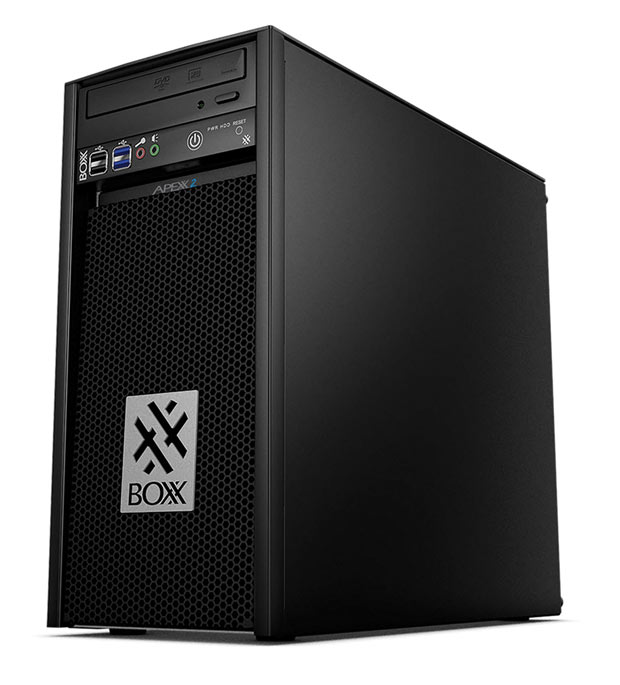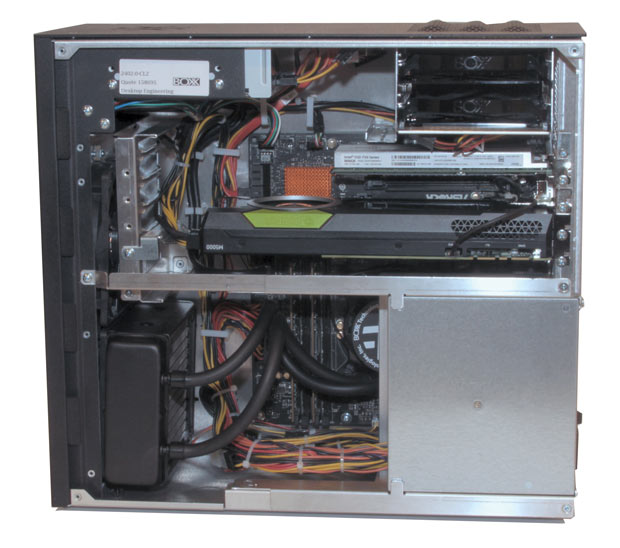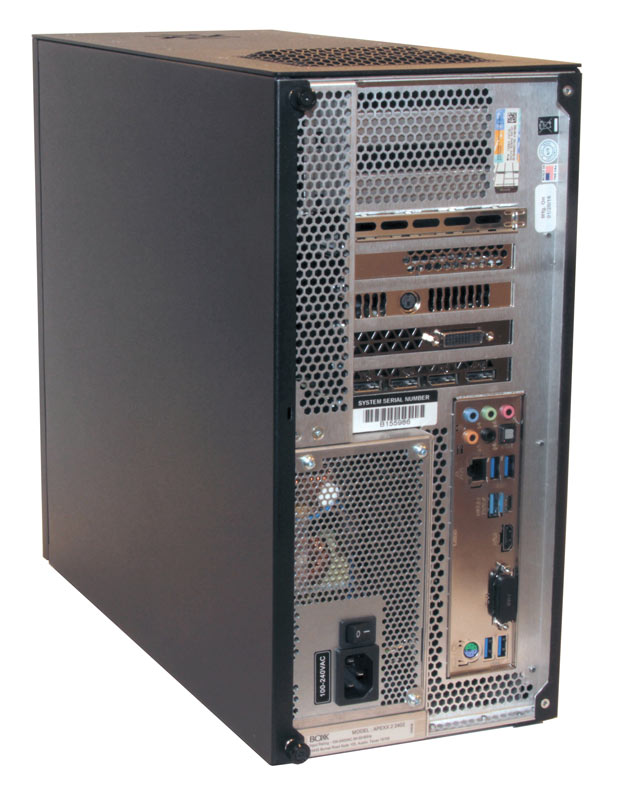BOXX APEXX 2 2402 Workstation Review: A New Peak Performer

The BOXX APEXX 2 2402 from BOXX Technologies houses a 6th generation Intel Core i7-6700K quad-core CPU overclocked to 4.4GHz. Image courtesy of BOXX.
Latest News
June 1, 2016
 The BOXX APEXX 2 2402 from BOXX Technologies houses a 6th generation Intel Core i7-6700K quad-core CPU overclocked to 4.4GHz. Image courtesy of BOXX.
The BOXX APEXX 2 2402 from BOXX Technologies houses a 6th generation Intel Core i7-6700K quad-core CPU overclocked to 4.4GHz. Image courtesy of BOXX.After testing the diminutive APEXX 1 from BOXX Technologies, it seemed only fitting that we follow up with a look at an updated version of the more conventional BOXX APEXX 2. When we reviewed the original APEXX 2 last year, it proved to be one of the fastest single-socket workstations we had ever reviewed — not a big surprise because the company has consistently delivered some of the fastest over-clocked workstations.
Our original APEXX 2 2401 came with a 4th generation Intel “Devil’s Canyon” CPU, a processor featuring 22nm lithography and improvements in thermal efficiency compared to the previous Haswell and Broadwell processors. The new APEXX 2 2402 is based on a 6th generation Skylake CPU. The new APEXX 2 gave us a chance to compare two nearly identical workstations to see for ourselves whether Skylake lived up to Intel’s performance improvement claims.The BOXX APEXX 2 2402 came housed in a custom-designed aluminum chassis measuring 6.85x16.6x14.6 in. (WxDxH) and weighing 19.75 lbs. As in previous BOXX workstations, the front grille conceals a pair of 4-in. diameter cooling fans and holds a filter to trap dust before it can enter the interior of the case. On the APEXX 2, one of those fans is actually part of the CPU liquid cooling system.
A single 5.25-in. drive bay above the front grille housed a 20x dual-layer DVD+/-RW optical drive as well as a panel containing two USB 3.0 ports, two USB 2.0 ports, audio jacks for headphone and microphone, a round power button with bright-white LED power indicator, a blue hard drive activity light, and a small reset button. A Blu-Ray R/W drive is a $212 option.
The rear panel provides four additional USB 3.0 ports, a USB 3.1 Type A port, a USB 3.1 Type C port, an RJ45 network jack, HDMI and DVI ports for the CPU’s integrated graphics, a PS/2 mouse/keyboard port, an S/PDIF out port and five audio connectors (microphone, line-in, line-out/front speaker, center/subwoofer, and rear speaker).
Updated Interior
Loosening a pair of captive screws and removing the right side panel reveals a compact but well-organized interior. In addition to the single drive bay with front panel access, there are also three internal drive bays — two 3.5-in. bays with quick-release drive mounts and a 2.5-in. bay.
The new APEXX 2 2402 uses an ASRock Z170M Extreme4 motherboard, with the CPU beneath a BOXX-labeled liquid cooling system. The only CPU BOXX offers in the APEXX 2 2402 is the Intel Core i7-6700K quad-core CPU. Although this processor has a base frequency of 4.0GHz, the “K” designation indicates an unlocked CPU multiplier, meaning that it can be overclocked. In the new APEXX 2, BOXX overclocks the CPU to 4.4GHz.
 Although the interior of the BOXX APEXX 2 is quite compact, the CPU and memory sockets are still accessible with the power supply hinged out of the way. Image courtesy of David Cohn.
Although the interior of the BOXX APEXX 2 is quite compact, the CPU and memory sockets are still accessible with the power supply hinged out of the way. Image courtesy of David Cohn.The motherboard provides four memory sockets supporting 288-pin DDR4 DIMMs (dual in-line memory modules), and can accommodate up to 64GB of non-ECC unbuffered RAM. The $2,997 base configuration includes 16GB using a pair of 2133MHz 8GB modules. Opting for just 8GB would reduce the cost by $209, while maxing out the memory would add $1,422.
The motherboard also provides four expansion slots — three PCIe 3.0 x16 slots and a PCIe 3.0 x1 slot — and supports both NVIDIA SLI and AMD CrossfireX technologies. Although the CPU includes Intel HD Graphics 530, the base configuration comes with an NVIDIA Quadro K620 discrete GPU (graphics processing unit). BOXX also offers other graphics options from both NVIDIA and AMD as well as NVIDIA Telsa boards. Our system came with an NVIDIA Quadro M5000 graphics accelerator, the successor to the K5200 included in last year’s APEXX 2. This high-end GPU, which includes 2048 CUDA (compute unified device architecture) parallel processing cores, added $1,886 to the overall system price and provides four DisplayPorts as well as a DVI port and stereo connection. As installed in PCIe slot 1, the thickness of the M5000 blocked access to the adjacent PCIe x1 slot, leaving just the other two PCIe x16 slots accessible.
Updated Technologies
Unlike the original APEXX 2, which used a SATA-based SSD (solid-state drive) for its primary storage, the updated APEXX 2 comes standard with a 256GB SSD M.2 PCIe drive. A 512GB M.2 drive is a $390 option. The PCIe interface improves bandwidth and reduces latency, enabling SSD drives to exceed the I/O capabilities of drives using the older SATA interface.
Using the M.2 slot on the motherboard means that PCIe storage does need to consume an expansion slot. That was not true for the system we received, however. Instead of an M.2 drive, our APEXX 2 included an 800GB Intel 750 Series SSD (a $1,284 add-on) installed in PCIe slot 4. Other PCIe SSDs ranging from 400GB to 1.2TB are also available. Eliminating the base-configuration PCIe M.2 drive did reduce the system cost by $361. Customers looking for even more storage can still use the available internal drive bays to add SSDs or HD SATA drives ranging from 120GB to 4TB, and the integrated drive controller supports RAID 0, 1, 5 and 10 configurations.
 The rear panel of the BOXX APEXX 2 provides plenty of connections, including both DVI and HDMI ports for the integrated Intel HD 530 graphics. Image courtesy of David Cohn.
The rear panel of the BOXX APEXX 2 provides plenty of connections, including both DVI and HDMI ports for the integrated Intel HD 530 graphics. Image courtesy of David Cohn.A 550-watt 80 Plus Gold power supply is tucked into the bottom rear of the case, mounted to a hinged support system that pivots out of the way after removing two screws.
Improved Performance
So how did this updated BOXX workstation perform? On the SPECviewperf tests, the new APEXX 2 2402 surpassed the performance of every other single-socket workstation we have ever tested, including last year’s first generation APEXX 2.
For our SOLIDWORKS test, we have recently begun using the new SPEC SolidWorks benchmark and could therefore not compare the new system to its predecessor. But again, the APEXX 2 beat all of the other workstations we have evaluated thus far using this new benchmark.
On the AutoCAD rendering test, which clearly shows the advantages of fast CPUs with multiple cores, the new APEXX 2 beat last year’s model in spite of having a slightly slower quad-core CPU, leading us to believe Intel’s performance claims for its new Skylake CPU. In fact, only the recently reviewed Xi MTower CX, with double the number of CPU cores, could beat the rendering performance of the new APEXX 2.
Perhaps the most telling results, however, were those we obtained using the SPECwpc workstation performance benchmark, which includes six test suites representing vertical markets, which often have very different computing demands. While the new APEXX 2 lagged behind some systems equipped with more powerful CPUs, it outperformed the previous generation APEXX 2 in every suite and on every workload, with improvements as much as 50% on some verticals. On tests that focused on disk performance, however, the new APEXX 2 beat the previous generation by as much as 4x. Clearly, the new Skylake CPU and PCIe-based drives deliver significant improvements.
BOXX Technologies backs the system with a three-year warranty featuring premium next business day on-site service with 24/7 phone support during the first year and depot repair service with weekday daytime phone support during the second and third years. Premium support during the second and third years is available for an additional charge.
As equipped, the new APEXX 2 2402 we reviewed priced out at $5,806, nearly $700 more than the first generation APEXX 2 we received last year. Had we opted for the standard 256GB PCIe M.2 drive, however — which would nearly match the capacity of the SATA-based SSD in the system we tested last April — the new APEXX 2 would cost $4,883, $228 less than its predecessor. Either way, the new BOXX APEXX 2 delivers even better performance than before, continuing to make it a perfect choice for CAD and 3D modeling applications.
Single-Socket Workstations Compared
| BOXX APEXX 1 1401 one 4GHz Intel Core i7-6700K 4-core CPU over-clocked to 4.4GHz, NVIDIA Quadro K1200, 16GB RAM | BOXX APEXX 2 2402 one 4GHz Intel Core i7-6700K 4-core CPU over-clocked to 4.4GHz, NVIDIA Quadro M5000, 16GB RAM | Xi MTower CX one 3GHz Intel Xeon E5-1660 v3 8-core CPU over-clocked to 4.1GHz, NVIDIA Quadro M5000, 16GB RAM | Digital Storm Slade PRO one 3.1GHz Intel Xeon E5-2687W v3 10-core CPU, NVIDIA Quadro M4000,32GB RAM | Computer Direct Volta Pro one 4GHz Intel Core i7-4790K quad-core CPU, NVIDIA Quadro K5200, 16GB RAM | Xi MTower PCIe one 3.7GHz Intel Core i7-5930K 6-core CPU over-clocked to 4.32GHz, NVIDIA Quadro K5200, 16GB RAM | |
| Price as tested | $3,711 | $5,806 | $4,997 | $6,187 | $4,441 | $4,985 |
| Date tested | 1/30/16 | 1/30/16 | 1/25/16 | 10/18/15 | 7/12/15 | 12/13/14 |
| Operating System | Windows 7 | Windows 7 | Windows 7 | Windows 10 | Windows 7 | Windows 8.1 |
| SPECviewperf 12 (higher is better) | ||||||
| catia-04 | 34.95 | 133.05 | 126.16 | 78.54 | 103.66 | 98.53 |
| creo-01 | 33.45 | 108.3 | 107.44 | 65.60 | 91.62 | 86.66 |
| energy-01 | 2.56 | 11.44 | 11.65 | 6.31 | 3.73 | 3.49 |
| maya-04 | 31.22 | 101.53 | 97.68 | 63.79 | 75.92 | 72.18 |
| medical-01 | 11.41 | 45.12 | 45.78 | 25.99 | 31.33 | 28.84 |
| showcase-01 | 18.99 | 60.37 | 61.65 | 42.26 | 49.76 | 48.98 |
| snx-02 | 28.47 | 121.01 | 219.48 | 74.62 | 152.32 | 150.42 |
| sw-03 | 70.56 | 158.22 | 149.88 | 110.74 | 134.67 | 126.08 |
| SPECapc SOLIDWORKS 2015 (higher is better) | ||||||
| Graphics Composite | 5.17 | 7.65 | 5.89 | n/a | n/a | n/a |
| Shaded Graphics Sub-Composite | 2.86 | 4.19 | 3.16 | n/a | n/a | n/a |
| Shaded with Edges Graphics Sub-Composite | 3.92 | 5.57 | 4.22 | n/a | n/a | n/a |
| Shaded using RealView Graphics Sub-Composite | 3.56 | 5.45 | 4.32 | n/a | n/a | n/a |
| Shaded Edges using RealView Graphics Sub-Composite | 6.17 | 9.01 | 7.20 | n/a | n/a | n/a |
| Shaded using RealView and Shadows Graphics Sub-Composite | 4.51 | 6.77 | 4.97 | n/a | n/a | n/a |
| Shaded Edges using RealView and Shadows Graphics Sub-Composite | 7.20 | 10.29 | 7.67 | n/a | n/a | n/a |
| Shaded using RealView and Shadows and Ambient Occlusion Graphics Sub-Composite | 7.78 | 14.87 | 11.94 | n/a | n/a | n/a |
| Shaded with Edges using RealView and Shadows and Ambient Occlusion Graphics Sub-Composite | 11.63 | 21.17 | 17.69 | n/a | n/a | n/a |
| Wirefram Graphics Sub-Composite | 4.17 | 4.19 | 2.98 | n/a | n/a | n/a |
| CPU Composite | 6.75 | 6.09 | 5.87 | n/a | n/a | n/a |
| Autodesk Render Test | ||||||
| Time in seconds (lower is better) | 46.30 | 41.70 | 25.30 | 47.33 | 50.83 | 42.33 |
| SPECwpc v2.0 (higher is better) | ||||||
| Media and Entertainment | 2.84 | 3.52 | 3.84 | 3.67 | n/a | n/a |
| Product Development | 2.46 | 3.06 | 3.38 | 3.89 | n/a | n/a |
| Life Sciences | 2.96 | 3.65 | 4.19 | 4.46 | n/a | n/a |
| Financial Services | 1.53 | 1.54 | 2.59 | 2.55 | n/a | n/a |
| Energy | 2.70 | 3.17 | 4.37 | 4.57 | n/a | n/a |
| General Operations | 1.93 | 1.99 | 1.78 | 1.47 | n/a | n/a |
Numbers in blue indicate best recorded results. Numbers in red indicate worst recorded results.
Subscribe to our FREE magazine, FREE email newsletters or both!
Latest News
About the Author
David Cohn is a consultant and technical writer based in Bellingham, WA, and has been benchmarking PCs since 1984. He is a Contributing Editor to Digital Engineering, the former senior content manager at 4D Technologies, and the author of more than a dozen books. Email at [email protected] or visit his website at www.dscohn.com.
Follow DE





